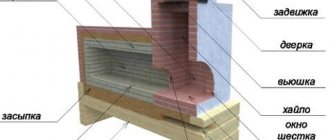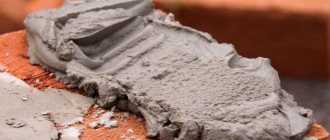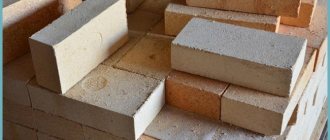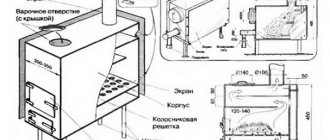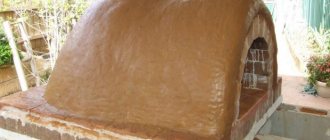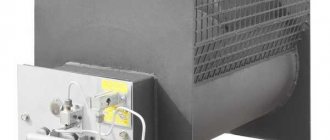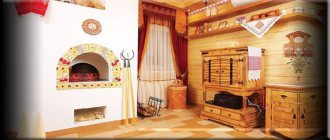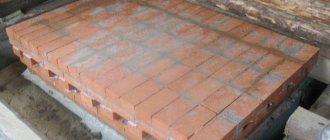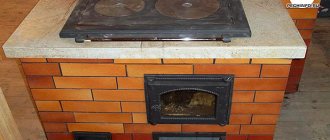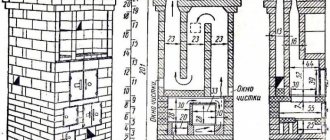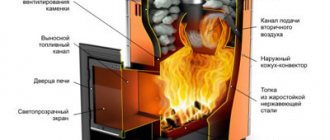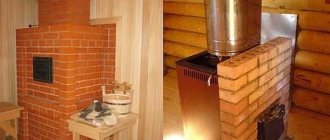Ecology of consumption. Estate: The facing materials used to decorate the ancient temples of our cities and the architecture of the Babylonians and Egyptians have too obvious advantages to send the technology of our ancestors into oblivion.
For many centuries, tiles have been a part of our culture. Gradually, this type of ceramics lost its former popularity. But over the last 20-30 years we have seen a renewed interest in decorating stoves with tiled elements.
Stove lined with tiles
For some time, the ceramic-finishing culture succumbed to the pressure of Western technology and the huge variety of tiles. But the facing materials that decorate the ancient temples of our cities and the architecture of the Babylonians and Egyptians have too obvious advantages to send the technology of our ancestors into oblivion.
German tiled stoves
Germany is a country of talented artisans, so it is not surprising that the most interesting antique stoves were made by German craftsmen.
Tiled stove at Heidelberg Castle
The 16th century was the heyday of the European Renaissance. The world of the “dark” Middle Ages was broken. People perked up, gained wealth and new self-confidence. This is a period of euphoria of the human spirit, which gave a lot for the development of European civilization in all areas of human activity.
The outstanding and most famous ceramicist of the Renaissance in Germany was Hans Kraut.
Rock earthenware oven from the Stockelsdorf factory in Lübeck
Johann Bartholomew Kraut (1532-1596), more often called Hans Kraut, was a potter from southern Germany, also known abroad. Creator of numerous ceramic products at the Austrian court. His most famous surviving work is a tiled relief stove from 1577, kept in the Victoria and Albert Museum.
Tiled stove at Heidelberg Castle
Hans Kraut is rightfully considered one of the most important ceramicists of southern Germany, for he was one of the first to bring Italian majolica across the Alps. He created many pieces new to Germany in the Italian Renaissance style, using drawings by Holbein and Raphael, although his main interest was in sculpture.
Tiled stoves at the Kiln and Ceramics Museum in Velten
Kraut made significant contributions to the decorative arts of Germany, using sculpture and bas-relief in his ceramics. His skill was so great that at the court of Archduke Ferdinand the Second he was accused of witchcraft, and as a result he was even buried outside the Christian cemetery. Two of his sons became followers of their distinguished father, and the name Kraut was famous among potters until the 18th century.
Museum of Kilns and Ceramics in Velten
German artisans have always been receptive to new trends in technology and pedantic in their implementation. The Germans were so successful in the production of stoves that over the centuries, molds for the production of ceramics were purchased from them by many European manufacturers of stove tiles and tiles. This is probably why the largest collection of various tiled stoves can be found in Germany, where applied art keeps pace with architecture, repeating all the main trends in art: from Gothic through the Renaissance to Baroque, Biedermeier and Art Nouveau.
Tiled stoves at the Kiln and Ceramics Museum in Velten
The heyday of German tile art occurred in the 17th-18th centuries. The tiled stoves at Hohenaschau Castle in Bavaria, Heidelberg Castle in Baden-Württenberg and many other castles in Germany date back to this period.
It is impossible not to mention the beautiful rock stoves made at the Stockelsdorf earthenware factory in Lübeck under the leadership of another famous German ceramist, Johann Buchenwald.
Tiled stoves at the Kiln and Ceramics Museum in Velten
Johann Georg Ludwig Boniface Buchenwald (1723–1806), an artist and director of several earthenware factories in Schleswig-Holstein, is one of the most important German ceramic artists.
Under the artistic leadership of Johann Buchenwald, German faience became one of the best in Europe, including in terms of its historical and artistic value.
Potbelly stove with Art Nouveau tiles in the museum in Velten
Another manufacturer of tiled stoves in Germany is the Meissen manufactory, which gave rise to the enterprise of Karl and Ernst Teichert, which produced tiled fireplaces and stoves until the mid-20th century. Noteworthy is the tiled wall produced by the Meissen manufactory, which still exists in Dresden.
But the most extensive collection of German ceramic tile stoves is collected in the stove museum in Velten. Such a large exhibition of stoves from all eras and styles, collected in one place, is probably not found anywhere else in the world.
Here are ancient Gothic tiled stoves, extraordinary Renaissance stoves, wonderful miniature Baroque stoves, intricately curved Rococo stoves and, of course, amazing Art Nouveau stoves.
Empire style tiled stove in the Kiln and Ceramics Museum in Velten
In one article it is absolutely impossible to describe all European tile and stove art - an entire book could be devoted to this. But we hope that we managed to interest you and perhaps you will take the time to visit the places we mentioned and especially the Kiln and Ceramics Museum in Velten.
Museum address
:
Ofen- und Keramikmuseum Velten
Wilhelmstraße, 32
16727 Velten
Telefon: 03304 / 3 17 60
Fax: 03304 / 50 58 87
- russian-mayolica.ru
Stylistics of modern tiled fireplaces
The native style of stoves with tiles is Russian ethnic.
However, harmonious design, good quality materials, and thoughtful design of the heating device itself allow you to create amazing design installations in a wide variety of stylistic directions. Particularly popular stylistic concepts:
- Baroque;
- Modern;
- Panel compositions;
- Oriental motifs;
- Art Nouveau;
- Ecological loft;
- European country.
The stylistic presentation is largely influenced by the “homeland” of the finishing material. Tiles from the town of Delphi are traditionally decorated with cobalt painting. The Flemish school is characterized by the use of blue and chocolate ornaments on white or ivory canvas.
590adb6d32d3daecb4301f090dbc309b.jpe b4efdc8885b7a839d098b321e180114e.jpe 06e5e3f27a7ed0a7b539588807036d08.jpe 60a2eb6aeb98f41c83753fff 38df753f.jpe eaddea461f69e0b2bc07ae21817a7a82.jpe 0682f11effd7e71af6a22f58298ec1da.jpe ef0ecc40afbcc087582efbba2bece98d.jpe d24cf55f98b659ecc195a029 aa5fd4de.jpe 2b53047993a00b311137a4dddcf614ff.jpe
Dutch graphics, which were complemented by interesting French motifs, were distinguished by particularly elegant and sophisticated Provençal watercolors. English fireplaces were decorated only with original British symbols. And today these motives can be freely used and these attributes are created, creating an aristocratic “purely British” interior.
Secrets of laying tiled fireplaces and stoves
Unlike a conventional stove, a feature of the tiled laying process is the installation of the tiles themselves first, and only then the attachment of the brick body to them.
Tile stoves are erected in several stages, simultaneously facing them with tiles. Therefore, such masonry is quite complex and labor-intensive; it can only be entrusted to good specialists.
Unlike other materials, tile finishing is carried out in parallel with the masonry. It is quite complex and labor-intensive. Therefore, such work should be trusted only to masters who know all the secrets of this ancient art.
The tiles used to cover stoves and fireplaces are non-standard piece products. Therefore, the first stage of work is always sorting them by color and rejecting tiles with glaze defects or cracks. Ideally, culling should be done before purchasing, but if you have already purchased tiles, then darker tiles are laid out on the bottom rows, and those with small defects are laid out in inconspicuous places.
The second stage is adjusting the size of the tiles by processing them with a grinder and grinding the edges. First, the first sample is processed, which is subsequently used as a standard, adjusting the rest to it. When fitting, first carefully trim the back edge, and then the glazed front edge, so that when laying the glaze of adjacent tiles does not touch. Before laying, for better adhesion to the mortar, they are soaked in water.
If the stove is installed simultaneously with the installation of tiles, use fireclay-clay mortar. If the finished stove is covered with tiles, then it is better to use special Profix glue.
The construction of stoves and fireplaces begins with the laying of tiles. Bricks are then attached to their first row. In order to check the placement of tiles vertically and horizontally, experts recommend first laying a wall of tiles without mortar. After checking, you can disassemble it and begin laying it on the mortar from the corners. The procedure for tiling simultaneously with brickwork is shown in the photo: 1 - brickwork; 2 - tile; 3 — tiller; 4 - pins; 5 — staples; 6 - knitting rows with wire; 7 — fastening loops.
The pump is half filled with stones, pebbles or granite and clay mortar. The solution is applied level with the sides and the brick is pressed against the tile. The tiles are fastened with wire when the brickwork reaches the height of its row. The wire is passed through the bent parts of the attachment crutches. Then the wire is taken out into the masonry. In vertical rows, the tiles are installed closely and secured with steel staples. So that when the brick base shrinks, the tiles settle along with it, the thickness of the seams between the horizontal rows of tiles must be at least 3 mm.
Which tiles are suitable for finishing a fireplace?
Basic selection options:
- impact resistance, wear resistance - directly affect the durability of the coating;
- design – the appearance of the fireplace should match the style of the room;
- moisture resistance – if there is water in the room (sauna, bathhouse);
- resistance to temperature changes - very important if the fireplace is the only source of heating in the room;
- thickness - the more the better, it is recommended that the option is no thinner than eight mm;
- porosity – it is advisable to use low porosity, as it is more durable;
- marking tiles - the use of category “A” is more acceptable, since the dimensions of the product are as accurate as possible, the pattern is clear, which is very important when laying out complex patterns.
There are many types of finishing materials based on ceramic tiles:
- terracotta is a strong and durable material, frost-resistant and vapor-tight. The tiles do not split upon impact, are practically scratch-resistant, are suitable for damp, heated and unheated rooms, and can be attached to any surface. A fireplace decorated with terracotta tiles heats up longer than others, and the coating tolerates sudden temperature changes well;
- tiles - used for highly artistic finishing of stoves, most often covered with glaze, almost any design can be applied. The heat transfer of the product is high, it is easy to care for, but the cost of the material is high;
- porcelain stoneware – combines the best properties of granite and ceramics, is resistant to temperature changes, does not crack, does not mold, does not fade in the sun, and is available in various color options;
- clinker tiles - made from several types of clay, with the addition of fireclay powder. The thickness of the material is 9-13 mm, it is easily installed using hot-melt adhesive, but when decorating a summer kitchen, the latter is frost-resistant. Clinker tiles are low-porous, wear-resistant, impact-resistant;
- majolica - has been used since ancient times; its composition is an improved terracotta, with a pattern applied to it, covered with a transparent glaze. The price of the material is high,
- tiles are heat-resistant and tolerate temperature changes well, but in the cold the material quickly deteriorates and crumbles. Matte options are preferable for fireplaces - they do not crack. Installation is carried out using heat-resistant compounds or without glue - in a metal frame;
- fireclay tiles - made from stone flour and refractory clay, are acid-resistant, fire-resistant, can withstand extremely low temperatures, and do not wear off.
DIY tile installation technology
For self-installation, purchase a special composition - tile adhesive. On the back side of the tiles there are usually special notches that increase the adhesion of the parts to the base. It is recommended to reinforce the structure with large-mesh reinforcing mesh, secured with screws or nails. Next, the mesh is covered with a mixture of sand, clay, high-grade cement, with the addition of polymers. The seams are grouted so that they are even; special plastic crosses are used when laying. The evenness of the coating is checked with a level and plumb line.
Austrian tiled stoves
Hohensalzburg, an ancient fortress on top of the Festungsberg hill in the city of Salzburg, built in 1077 by Archbishop Gebhard, is one of the largest medieval castles in Europe. Since then, the fortress has been rebuilt several times, so today only the foundation remains of the Gebhard building. Despite the powerful walls and impressive appearance of the castle, it always surrendered to the enemy without a fight.
In its entire history, the castle was besieged only once, and even then it was about an armed uprising of peasants in 1525, and frightened feudal lords were holed up in it. Now the castle has the largest collection of exhibits of the military history of Austria and one of the largest collections of military weapons from different historical eras.
Ceramic oven at the Innsbruck Craft Museum
In the Hohensalzburg fortress, two of the oldest tiled stoves in Europe from the 16th century have been preserved. These stoves are of medieval Gothic art and are lined with ceramic tiles coated with lead glazes. The tiles preserve beautiful sculptural images of religious scenes (“The Expulsion of Hagar” from the Old Testament), the twelve apostles and reigning persons.
Historical tiles found during excavations of the Lower Castle
Another masterpiece of Viennese architecture is the Kinski Palace in Vienna. It is interesting not only because it is an unusually beautiful building in the Baroque style, but also because it is a fully functioning building. It hosts art auctions as well as social and diplomatic events. For example, it was there that the EU negotiated the status of Kosovo.
Lower Castle in Vilnius
The palace was commissioned by Count Wirich Philipp von Daun and its construction began in 1717 under the direction of the architect Johann Lucas von Hildebrandt. In 1784, the palace was sold to Count Franz Joseph Kinski, director of the Vienna Military Academy and author of many works on military science. The palace is often called Daun-Kinski after the names of its famous owners. The palace belongs to the Baroque style, has numerous works of art in its interiors, and the facade and its decorative elements set the style for the whole of Vienna until the 19th century.
Historical tiles found during excavations of the Lower Castle
A remarkable tiled stove from 1740 has been preserved in the Kinski Palace. This stove is a typical representative of Viennese stoves of the 18th century; it has landscape and genre painting panels, numerous relief friezes and, of course, sculptural “legs” in the form of lions.
Reconstructed 16th century tiled stoves in the Lower Castle
Crafts Museum in Innsbruck. In 1888, in the face of advancing industrialization and in the wake of the Arts & Crafts movement, Tyrolean artisans decided to open a museum of folk arts and crafts. By 1903, the museum was opened in the building of a former Franciscan monastery in Innsbruck. The museum's collection included beautiful examples of applied art belonging to a wide range of social strata. Here you can find things from peasant life, religious objects, and exquisite art objects from the homes of the Tyrolean nobles and bourgeoisie.
We present to your attention an elegant ceramic stove from the Innsbruck Museum of Applied Arts. This is a cobalt tiled stove in the Renaissance style with white faience bas-reliefs.
Finishing the stove with tiles
A stove lined with tiles is very beautiful, hygienic, and easy to maintain. In addition, the facing layer additionally covers the seams and increases the heat transfer of the stove. Finishing work when facing with tiles is always carried out simultaneously with the laying of the furnace rows. This type of work requires high qualifications and skill.
First of all, it is necessary to select the tiles. The selection is based on color, shape and size. The form is subject to requirements for the absence of sagging, external and internal cracks. The color range is sorted by shade. It is customary to use darker tiles for cladding the lower parts. The lighter the color, the higher the tile is located. Sorting by size should select standard tiles.
A non-standard size is trimmed using special techniques using a sharpened steel strip and a steel rod. Using a stove hammer or pick can crack the tile
Places where the tile is cut are carefully polished
If it is necessary to saw through the tile, it is recommended to use thin steel wire. The outer glaze is marked with a marker and an external groove 2-4 mm wide is made along the cut line. Sawing is carried out downwards with the back side, holding the tile with both hands.
Tiling technique
Working stroke when moving the tile towards itself
After sawing, the tile is carefully and carefully polished with smooth circular movements, its horizontal sides are slightly beveled. A mandatory rule is to wet the tile before laying.
The tiles are fastened using special rectangular brackets made of elastic steel strip, 15 mm wide and 2 mm thick. The requirement for bracket rigidity is related to the reliability of fastening the tiles.
The number of staples is two per tile. In addition to the staples, you will need steel wire with a diameter of 4-5 mm to make pins, one per tile. The pin has a curved end and is inserted into the holes of the tiller. The total length of the wire is determined by the number of tiles and the length of the pin 30 mm greater than the height of the tile. The length of the annealed wire for connecting rows of tiles and organizing loops is approximately found by adding the product of the length of one row of masonry by twice the number of rows with the product of twice the number of tiles by 0.2 m. All data will be approximate and will be updated during the work.
Facing with tiles begins with laying without mortar the bricks selected for the outer wall and its subsequent disassembly, leaving one row. Set up the corner tiles of the bottom row using a level, plumb line and square, as a rule. Each tile is smeared with a solution, and a thick layer of solution is placed under the tiller. The space between these tiles is filled dry with the rest of the tiles in the row, their sizes are verified and adjusted. The tiles should fit as tightly as possible. If there are practically no vertical seams, then tiling requires the presence of a horizontal seam of 2-3 mm for shrinkage with the brickwork. The tiles are fastened to each other using staples and wire twists; the tiles are attached to the masonry wall with special wire loops.
We build and repair ourselves
How to choose a chainsaw Choosing a chainsaw is not a quick decision. If you want to use a chainsaw in the garden or on a country site, then a household saw is suitable for you. As a rule, a household saw is used occasionally...
Finishing the facade of a wooden house Of course, a wooden house itself has an aesthetic appearance. It’s as if the natural color and material it has merges with nature. This is what creates the feeling...
Polymer self-leveling floors Every day, decorative polymer floors are becoming more and more popular in residential construction. At one time they were developed to cover large areas in industrial and…
Installing doors yourself In this article, I would like to talk about how to assemble a door frame and install it. If you are planning to change your doors and don’t know where to start, then we will help you with this. The main thing...
Insulating a house with your own hands Current building codes require mandatory thermal insulation of building walls. There are many types of facade thermal insulation, but the most preferred…
Lithuanian tiled stoves
The main building of the Vileisis Palace
One of the remarkable objects of the cultural and historical heritage of Lithuania is the Vilnius Lower Castle, which now houses the Museum of the Rulers of the Grand Duchy of Lithuania. The restoration of the castle is probably one of the most large-scale projects to revive Lithuanian statehood and resurrect from oblivion many beautiful examples of medieval art. The exhibition is presented in chronological order, and it covers three main periods in art: Gothic, Renaissance, early Baroque.
Round ceramic oven in Vileisis Palace
During restoration and archaeological work, mosaics, ceramic and stone architectural elements and many ancient stove tiles were found dating back to the reigns of Sigismund the Old (1506-1548) and Sigismund Augustus (1548-1572). In total, more than 300 thousand artifacts were found during excavations. The museum's exhibition covers the periods from the 13th to the 17th centuries, right up to the entry of the Grand Duchy of Lithuania into the Polish-Lithuanian Commonwealth and its loss of statehood.
Green fireplace in Art Nouveau style in the bedroom
Stove tiles constitute the largest group of architectural ceramics in the Lower Castle. More than twenty different types of tiles with princely coats of arms and allegorical images of mythological and biblical characters were found.
The largest number of tiles found on the territory of the Lower Castle date back to the Renaissance. These are tiles with multi-color glaze and scenes from engravings by famous German artists of the 16th century: Lucas Cranach, Albrecht Durer, Hans Sebastian Beham. Nowadays, the stoves of the 16th century have been reconstructed in the Lower Castle.
Tiled stove from Abo kakelfabriks aktiebolag (AKF) factory
An equally outstanding example of art from the early 20th century is the architectural ensemble in Vilnius - the Vileisis Palace, built in 1906 by order of Petras Vileisis by the architect August Klein.
Hohenashow Castle
Petras Vileisis (1851-1926) - Lithuanian politician, engineer and philanthropist, educator and champion of the revival of Lithuanian writing and national Lithuanian culture.
Relief tile by Hans Kraut
Initially, the architect proposed two designs for the palace - in the neoclassical style and in the neo-baroque style. Vileishis chose neo-baroque due to the proximity of the future castle to the Catholic Church of Saints Peter and Paul in the Baroque style, rightfully considered the pearl of this style.
The palace was built by Vileishis not only to house his family, but also to host various cultural events. Already since 1907, the palace regularly hosted art exhibitions of Lithuanian artists.
Kraut's tiled stove at the Victoria and Albert Museum, 1577
After World War II, the palace building was transferred to the Lithuanian Academy of Sciences, and since 1947 it has housed the Institute of Lithuanian Language and Literature.
In the palace, which has interiors in classical, neoclassical and baroque styles, thirteen stoves made in the same styles have been preserved
Particularly noteworthy is the green fireplace, made in the then fashionable art nouveau style.
Gothic tiled stove at Hohenaschau Castle
The tiles for the stoves in the palace were made by the Finnish Abo kakelfabriks aktiebolag (AKF), whose models we actively use in our work and which we wrote about in our article about Finnish tile stoves of the early 20th century. An interesting fact is that in the living room of the Vileishis Palace there is exactly the same tiled stove in the Baroque style as in the reconstructed Vsevolozhsky Estate in Moscow.
What are tiles
The meaning of the word (etymology) is interpreted differently by many, but it comes from the old word “to express”, i.e. cut out. Essentially, tiles are tiles made of baked clay (ceramics), which differ from others in their configuration, namely, the presence of a rump.
Rumpa, what is it and why is it needed?
The tile rum (see figure) is a box-shaped protrusion on the reverse (back) side of the tile. The pump gives strength to the tiles and increases the heat capacity of the oven. It is slightly smaller in size than the area of the product.
It is this key feature that makes ceramic tiles an ideal facing material for home stoves and fireplaces.
The same hollow design is also characteristic of tiled decorative elements for cladding walls, facades, fireplaces and stoves.
Advantages of tiles over tiles
strength and rigidity. Achieved due to the thickness of the product - the tile is 2 times thicker than ceramic tiles;
ability to withstand any temperature;
resistance to temperature changes;
heat accumulation. A well-heated stove can give off heat throughout the day;
environmental friendliness. This is achieved due to the fact that clay is used in production, and also due to the fact that dust does not linger on the surface of the tiles (in particular, glazed ones). It does not burn and does not emit substances harmful to users;
ease of care;
fuel economy. The pump chamber retains heat for a long time, thereby reducing fuel consumption and increasing heating duration;
eliminating the possibility of burns upon contact with the oven surface. Due to the internal chamber, the temperature of the tiled stove (outer walls) is not high;
low moisture absorption;
the heat generated by a tiled stove is comparable to that of the sun;
long service life, confirmed by practice;
historical value. Ancient tiles are well preserved in the estates of the Russian nobility. And today, many users strive to make housing in a traditional style.
Of course, the aesthetic properties of the tiles are beyond competition. Thanks to the variety of their types, any design project can be turned into reality. A tiled stove will fit perfectly into any design - from classic to modern. Even laconic high-tech could not resist the charm of stove tiles.
Selection of tiles for cladding
Master tilers have created many different tile configurations, allowing for the construction of a beautiful and functional tile stove. So, for example, smooth tiles are used when finishing planes; for facing corners, corner tiles with a tumbler of the appropriate configuration are provided. Curves and decor are made by shaped parts (border, straight and corner cornice, grille, relief inserts, cover shelf, firebox frame).
a258d310be109ce3dfd2dd6dab1f6045.jpe aed7fa2eb68463740a7d5f7a8c7388fa.jpe 5cf33b3bc9c1c6290b9f1ad3d218ac89.jpe 36b71782c67d67733ebccde26173ad2 7.jpe
cc96125be9b7bce5702db19dde2af90f.jpe
2b84fa8c652425f0a15bccb6423a0688.jpe
Not only the types of tiles can be different, but also the method of making the front surface. Here there are relief, smooth, with and without patterns, glazed and terracotta surfaces. The method of applying the design and its color scheme determined entire schools of ceramists. Dutch, Spanish, and Russian tiles have gained popularity.
But the sizes of tiles, on the contrary, are unified and regulated by GOST 3742-47. The document contains information about the geometry of the tile and permissible deviations from the norm. The latter are no more than 1 mm. Standardization made it possible to avoid the lengthy adjustment of tiles to each other, which significantly reduces the tiling time.
How to check the quality of a tile
When buying a tile, you need to be guided not only by its aesthetic properties, but also pay attention to such indicators as:
- raw materials. Masters claim that durable tiles can only be made from white clay. Colored clays contain various impurities that affect quality;
- presence and size of pores. You don't need to break the product to see the pores. They are clearly visible at the ends of the tile. The larger the pore size, the more moisture the product can absorb. The percentage of moisture absorption determines the tile’s resistance to temperature changes and mechanical damage. Accordingly, the larger and larger the pores, the lower the quality of the product;
- method of making tiles. In industrial quantities, tiles are made in two ways: punching, pressing and casting. In the first case, wet clay is used, which simplifies the production process, but increases the drying time of the product. In addition, during the drying process, a wet product may move, which will violate the specified dimensions. The second option is more labor-intensive, but the finished product is more durable and has identical dimensions. The third method is used to obtain “tiles for tiles”;
- number (number) of firings. They can be determined by the quality of the front surface. If it is slightly cracked and has a duller shine, it means that the tile was fired once.
Cladding the stove with tiles step by step instructions
The technology of finishing with tiles, like any construction process, is sequential and begins with the formation of the first row.
The first row of tiles or the so-called “hooves” set the tone for the entire construction. Their correct installation is the key to quick and high-quality further installation.
Installation of the first row
tile preparation;
- selected and numbered tiles are immersed in water. This will avoid a situation where the clay of the tile will draw moisture out of the solution;
- After extraction, the rum of each tile is filled halfway with clay. Filling the pump increases the heat transfer of the furnace;
- then filler is packed into the clay. This can be brick, gravel, pebbles;
- the resulting voids are filled with clay;
Note. Many craftsmen use the ready-made mixture to fill the pump. Composition of the mixture: clay, quartz sand and brick in a proportion (ratio) of 1:2:2.
laying tiles begins with the installation of corner elements;
installation of central tiles. After the first row is laid out, it is necessary to tighten the tiles together with a steel pin. To prevent the tiles from sliding, it is recommended to bend the pin from above. Its lower edge will rest against the tiller;
tiles in vertical and horizontal rows are connected to each other using steel brackets.
a soft wire attached to a pin will allow you to connect a row of tiles to a row of stove bricks. The wire is tied to the pin. A loop is formed at its end, which is inserted into the brickwork. For a reliable connection, two wire loops should be tied to each pin.
Note. Hinges for connection with the furnace masonry are installed during the construction of the furnace. Installed in advance, they will interfere with work.
The procedure for attaching the tile is shown in the photo.
After the first row has been laid, the seams need to be cleaned. This will help you apply the grout more accurately in the future. And also clean the tiled surface from washing.
Laying subsequent rows of tiles
After the first row is laid, another one is laid out in the same way. After this, the masonry of the stove or fireplace itself is carried out. After several rows of bricks have been laid, the space between them and the tiles is also filled with clay.
Cleaning the stove and grouting the joints between tiles
The tiling of the tiled stove is completed by cleaning the surface. To do this, use a soft cloth or paper. The final touch is to seal the seams (grout), if any were allowed during the work process. To grout the joints between the tiles, liquid gypsum dough is used, which is used to lubricate the joint spaces. After 10-15 minutes. After the dough has dried, remove any remaining residue with a soft cloth.
Note. No matter how much you would like to heat the built and lined stove, you should not do this earlier than a week after completing all the work. And even then, the trial fire lasts no more than an hour. A full check can be performed after the clay solution has completely dried - after 3-4 weeks.
Drawing (tile painting, engobing)
Like almost all ceramics, tiles can be painted using the following methods:
Cold painting
The drawing is created with ordinary oil paints. Before coating, the tile must be covered with natural drying oil, dried for 1-2 days, and then painted.
After the paints have dried, to obtain a more beautiful surface and make the paint more durable, the tile can be coated with oil varnish. The good thing about this method is that it does not require additional firing.
For those who make tiles for the stove with their own hands, this is the least labor-intensive option. At the same time, different parts of the design can be applied to different tiles. When laying out the tiles, you will get a large pattern covering the entire surface of the stove.
Painting with colored engobes (engobing)
Engobe is a decorative coating made of liquid clay (clay suspension), which is used to cover ceramic and pottery products before firing to obtain a smooth surface or to give the desired color.
Engobe for painting tiles can be obtained in two ways.
First, choose types of clay of different shades. Secondly, color the white clay with coloring pigments. This drawing technique is divided into two subtypes:
- applying clay brought to the consistency of thick sour cream;
- dipping the tile into water and then into white engobe. After the white background has dried (but not completely dried), a design is applied to it using colored engobes.
Engobing tiles - video
Note. If further glazing of the tile is not planned, craftsmen recommend adding 10-20% flux to the engobe. Flux is a silicate glass that gives paints shine. Glass powder is made independently by crushing glass in a container. To prevent the spraying of particles, work is carried out with glasses and gloves, and the container with the pestle is placed in a durable transparent plastic bag. Large particles are removed by sifting the powder through a sieve. A nylon stocking stretched over a base, such as an embroidery hoop, is well suited for these purposes.
The pattern will give a smooth or embossed tile a unique beauty. When choosing a design, you can use motifs that are conveyed by Dutch, Spanish or Russian tiles as a theme.
To fix the applied design, the tile must be fired again.
Peculiarities
A distinctive feature of such tiles is the presence of a rump - a box-shaped protrusion on the reverse side. Thanks to this feature of the products, their strength increases, as well as the overall heat capacity of the heating device. The production of elements in the form of volumetric products is a significant difference between products and ceramic tiles.
The unique structure of the tile makes it the best material for lining stoves. The raw material for making tiles is clay. As the temperature rises, its expansion rate is the same as that of the brickwork, giving the material excellent heat transfer properties.
The main advantages of tiles include:
- resistance to temperature fluctuations;
- good strength indicator, which is achieved due to the thickness of the product;
- heat accumulation - a heated stove will release heat into the room for about a day;
- low moisture absorption rate;
- ease of maintenance;
- fuel economy;
- low level of injury hazard of the material - contact with the surface does not cause burns;
- long service life;
- historical significance.
The attractiveness of tiles is unrivaled. A stove decorated with such products will harmonize perfectly with the interior of a room in a modern high-tech style or in the rustic style of decoration, which was popular even under the Tsar.
Modern stove models are designed in such a way as to use a minimum of fuel, which means saving money on heating the room. Modern universal designs work perfectly on natural raw materials, as well as alternative fuel options.
DIY cladding
Oddly enough, there are those who want to not only make a fireplace with their own hands, but also not look for the cladding material for it in the store, but also make it themselves. Such people will be pleased to hear that clinker or gypsum tiles are very easy to make on their own.
For clinker you will need: silicone mold, gypsum, sand and cement. All the necessary “ingredients” are mixed and poured into the mold. After 15 minutes everything is ready, you just need to dry it and cover it with a primer so that nothing falls off.
To make gypsum tiles you will need: silicone mold, gypsum, slaked lime, water. Everything is mixed and poured into the mold, but it must be done quickly, otherwise the plaster will begin to harden at the most unfortunate moment. After 15-20 minutes, the material can be removed from the mold and left to dry further; this must be done carefully, because the structure is still very fragile.
Preparing tiles for cladding
Considering the method of making tiles, it can be noted that all tiles will differ in size and shade.
It’s easier with the size - all the tiles are adjusted to the same size using a grinder and grinding with a rasp. Moreover, if you need to cut the product into pieces, you first need to cut down the front glazed surface.
Note. In order not to damage the surface of the tile during further grinding, you must first make a small bevel on the glazed surface. Thus, the tiles will rest on each other with an edge, and not as a decorative surface. This will not affect the quality of installation in any way.
But if the size can be brought into uniform compliance, then attention should be paid to color. Products should be grouped in such a way that the transition between shades is as less noticeable as possible
At the same time, craftsmen advise laying tiles with dark shades at the bottom.
Products with detected defects (cracks, chips, design defects) may be useful for trimming. They can also be laid at the junction with the wall or other inconspicuous places.
Options for laying tiles: the first pattern is with sorting, the second is without.
The approaches to installation are not limited to this and are determined by the design, the relief of the tile and the imagination of the author.
Material prepared for the website www.moydomik.net
Stone cladding
The use of natural or artificial stone, as can be seen in the photo of the fireplace decoration, will create a very durable coating. Along with this advantage, the simplicity of masonry should also be noted. After all, the craftsman will not be required to create perfectly even seams. On the contrary, some carelessness can become the highlight of the decoration.
Among the most commonly used materials are:
Limestone and sandstone allow you to choose any decorative style, but their strength is low and they strongly absorb soot.
Granite – can be used both in its raw form and after polishing. The color palette is varied. The stone is durable and resistant to detergents.
Slate is an aesthetic and durable material, but it is demanding when choosing the right style.
Marble is distinguished by its decorative diversity and the ability to decorate a fireplace in interiors decorated in many styles.
